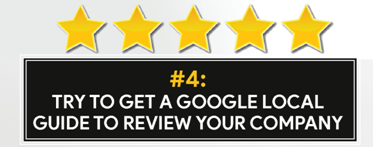
Did you know that more than 80% of all consumers say that they trust a product review from a stranger as much as they would a personal recommendation from a friend. Not only that, people trust user reviews more than the official descriptions of products.
Customer reviews are actually something that we can influence and control. There are many ways to encourage positive reviews. Of course, positive reviews have a direct connection to excellent customer service.
Can you afford to wait for the customer to decide to review your business or not?
You don’t have to wait on clients to. We have put together six wise ways you can get more positive reviews online.


Do customers receive an email from you after purchase?
Opposed to the confirmation email that customers receive with an order number if they order online, we mean an email where you specifically ask them how they like your business. This email is a perfect spot to request that they write a review. (Caveat: Yelp does not allow businesses to solicit reviews, but all the others do.)
Many organizations have adopted this policy – and for good reason. There will always be people who leave online reviews after every business transaction.
On the other hand, some people need a friendly reminder to leavea review for your business, otherwise they will simply forget. A specific place to call for action from a client is in the “Review Us” section of your website with a review link attached.
-A review request should be emailed to customers days after purchase. This time allows customers to fully experience the product and service so they will be able to provide a quality review.

The benefit of using these providers is that they can get you a bunch of reviews at once. They’re real reviews from real people and they can give your page instant credibility.
The downside is that the reviews aren’t from your customers. They’re from people who have bought the product – and they’re all verified. That’s the good part. The less-great part is that they can’t and won’t be providing reviews of YOUR business, including your ambiance, customer service, and other key drivers of business.
These providers are a good option for start-up businesses because they can make your website appear to be well-established and popular. As you go, you can supplement the reviews you get through a service with new reviews from your customers.

For example some Uber drivers practice this policy. Drivers will request passengers to leave a review just before they reach their destination. This simple request reminds customers to rate their service before they are distractied with normal daily life.
The experience is fresh in a customers mind when a purchase is completed. A cashier who provides a friendly checkout and some banter is ideally placed to ask for a review because they have an opportunity to build a working relationship with the client.
This method of recieving reviews can be encouraged by printing cards asking for reviews and putting links to your review pages on your website. You don’t want customers to be confused about what to do – eliminate the guesswork and your buisness will benefit.

Google Local Guide is a program owned by Google that designates certain reviewers as local experts.
The process of getting a local guide can be a complex one, but here are some tips to help you do it:
Make sure your Google My Business listing is up-to-date and active
Join Google Local Guides on your own – you can write reviews of local businesses and raise your visibility provided you don’t use the platform to promote or favor your business
Attend local events with other guides
Invite other guides to come to your business
This isn’t a quick fix, but the nice thing about Google Local Guides is that when a local guide reviews your business, their designation shows up in the review and that gives it more weight than it would have otherwise. Another benefit is that Google requires guides to use their real names, so there’s less of the anonymous ranting that shows up on Yelp.

Automation means that there’s no worry that a stressed-out employee will forget to ask. It turns the process into part of your customer service – a hands-off way of encouraging customer feedback and garnering the kinds of reviews you want.
Here are a few suggestions to help you automate your system:
Set up an autoresponder to send an email requesting a review. Instead of manually sending those emails, link the date of a customer’s purchase to their email and have it go out on schedule. If you link customer purchases to your email marketing provider, you can rest easy knowing that every customer will get a request for a review.
Print up review request cards and put them in the customer’s bag at checkout. This method eliminates the need for your cashier to ask for a review, and makes it simple to do even at times when you’re busy and have a line at the register.
Put review links on your product pages. That way, when a customer makes a purchase they can easily read reviews of it – and it may help to remind them to leave a review after their purchase.
Automating your review request system makes good business sense because it eliminates the guesswork.


Your review system should:
Specify whose job it is to ask for reviews
Specify the language to be used when requesting a review
Specify methods to be used (email, conversation, links and printed cards, to name a few)
Specify the timeframe for requesting reviews
Lay out procedures for responding to both positive and negative reviews
If you codify your system for requesting and managing reviews, you can be sure that there isn’t any confusion and that customers always get the request you want them to get.
Don’t Sweat the Negative Reviews…
We’ve focused here on garnering positive reviews for your business, but don’t get too stressed about negative reviews. If you handle them properly, they can help your business too!
Respond quickly and graciously and offer solutions. Don’t get defensive. Many businesses use negative feedback to demonstrate that they care about their customers.
If you’re getting so many reviews that you’re having trouble keeping up, you may want to consider using an online review management system to help you – and having too many reviews is the problem you want to have! That’s how businesses grow.
